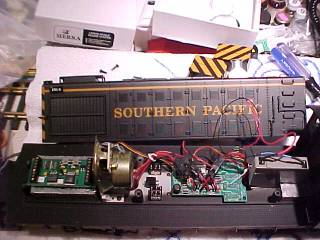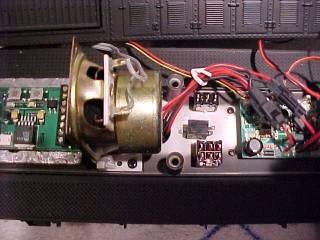I have one of the new USA S-4 locomotives in which I recently installed Sierra sound. This was one tough installation job due to the small amount of space available under the hood. The locomotive has no provision to mount a speaker in the very small fuel tank like others do, so it must be mounted inside the body shell. The hood comes off easily since it is held on with only six screws. USA has provided a plastic bracket with two small screws on the floor near the front weight where an oval Phoenix SP-2.50 speaker fits perfectly. The speaker faces forward so that your sound comes out through the radiator shutters and the grill on the top of the hood. There are two more plastic ears molded into the top of the hood which hold the top of the speaker in place when the body shell is re-attached. This actually turns the front of the hood into a sound chamber with minimal sound being sent to the rear of the locomotive. The battery for the sound system fits over the rear weight, but has to be in a standing position with the leads pointing up. The sound card itself was foam taped to the front body weight which is in front of the speaker. There is just enough room here for this without interfering with reattaching the shell. I found room in the floor behind the speaker to drill holes for the charging jack, volume control, and on/off switch. These are actually hidden behind the battery boxes and do not interfere with the front truck.
As with my other installations the track power inputs are connected directly to the leads coming from the trucks rather than plugged into the circuit board. Using the board has a tendency to slow down the response of the sound card to throttle changes, and as yet I have not had the time to figure out why, unless there is a capacitor somewhere in the circuit. I trigger my horn with a reed switch and track magnets. The reed switch was installed on the right side of the locomotive behind one of the battery boxes on an air tank so that it cannot be seen. Once the shell was placed on the locomotive and fastened to the frame, the only thing left to do was to option the bell so that it would begin to ring and shut off at the proper speeds, and the horn to be triggered by the reed switch. All other options remained as set by the factory, except the dynamic brake sound which I disabled since this was not an option on a yard switcher.
If you want to run this locomotive on DCC, there is plenty of room for a decoder. I am not sure you can make this a battery powered locomotive and still retain the sound function, because of the space taken up by the speaker. I have a friend who is going to try it with an AirWire system, and I will write a report when I hear whether he has been successful.


